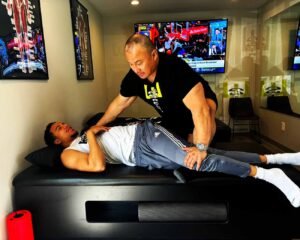
Understanding Assisted Stretching: What It Is and How It Works
Assisted stretching is a technique that involves a trained professional aiding an individual in performing stretches. Unlike regular stretching, which is typically done independently, assisted stretching requires the expertise and guidance of a trained professional, often a physical therapist or a certified trainer. This professional helps guide and support the stretches, ensuring that they are performed correctly and safely.
The mechanics of assisted stretching vary depending on the technique used. One common method is Proprioceptive Neuromuscular Facilitation (PNF), which involves a cycle of stretching and contracting the muscle. Another popular technique is Active Isolated Stretching (AIS), which uses repeated movements to stretch the muscle gradually. Both methods focus on enhancing flexibility and range of motion through controlled, assisted movements.
There are several physiological benefits associated with assisted stretching. Improved flexibility is one of the most immediate advantages, as the professional can help to stretch the muscle more effectively than self-stretching. Enhanced range of motion is another key benefit, as the guided stretches can help to overcome limitations that may not be addressed through independent stretching. Additionally, assisted stretching can significantly aid muscle recovery by promoting blood flow and reducing muscle tension.
Scientific studies and expert insights support the efficacy of assisted stretching. Research has shown that assisted stretching can lead to greater improvements in flexibility and range of motion compared to self-stretching. Experts in the field, such as physical therapists and sports trainers, often recommend assisted stretching as part of a comprehensive fitness or rehabilitation program. This is because the involvement of a trained professional ensures that the stretches are performed with the correct technique, reducing the risk of injury and maximizing the benefits.
In summary, assisted stretching offers numerous advantages over regular stretching. By involving a trained professional, individuals can achieve better flexibility, increased range of motion, and enhanced muscle recovery. These benefits are substantiated by scientific research and expert recommendations, making assisted stretching a valuable addition to any fitness or rehabilitation regimen.
Achieving Maximum Potential Through Assisted Stretching: Long-Term Benefits and Personal Stories
Assisted stretching offers a plethora of long-term benefits that can contribute significantly to reaching one’s maximum potential. One of the primary advantages is improved athletic performance. Enhanced flexibility and muscle elasticity allow athletes to execute movements with greater efficiency and reduced effort. This can lead to better performance in sports and physical activities, as well as a decreased risk of injury. By promoting muscle balance and joint health, assisted stretching plays a crucial role in maintaining overall body alignment, which can lead to improved posture and mobility.
Moreover, the mental well-being that accompanies a consistent assisted stretching regimen should not be overlooked. Stretching sessions often incorporate deep breathing and relaxation techniques, which can reduce stress levels and promote a sense of mental clarity and calm. This holistic approach not only improves physical health but also enhances mental resilience, making it easier to tackle everyday challenges.
Personal stories and success anecdotes highlight the transformative potential of assisted stretching. For instance, Jane, a 45-year-old office worker, reported significant relief from chronic back pain after incorporating regular assisted stretching sessions into her routine. Similarly, John, a semi-professional soccer player, attributed his enhanced agility and reduced injury frequency to the targeted stretches facilitated by his trainer. These real-life examples underscore the versatility and effectiveness of assisted stretching in addressing diverse health and fitness goals.
One of the most compelling aspects of assisted stretching is its adaptability. It can be tailored to meet individual needs and goals, making it suitable for people of all fitness levels. Whether you are a seasoned athlete or someone new to physical fitness, a qualified professional can design a stretching program that aligns with your specific requirements and objectives.
To incorporate assisted stretching into your regular fitness routine, consider scheduling sessions with a certified specialist. Many fitness centers and wellness clinics offer personalized stretching programs. Additionally, integrating a few stretches into your daily activities can yield substantial benefits over time. By prioritizing assisted stretching, individuals can unlock their full potential, achieving long-term health and fitness milestones.
